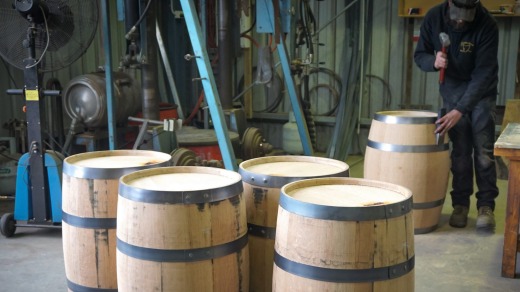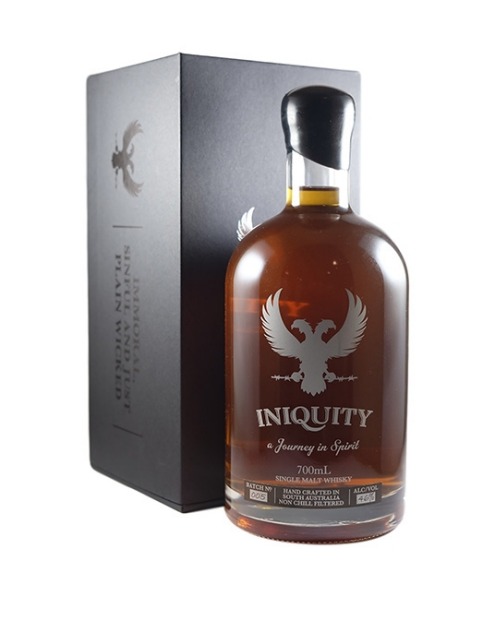If you've never experienced what it's like to walk into a dunnage full of whisky barrels, put it on your bucket list. These places smell like heaven, or what I imagine heaven should smell like if such a place existed and you were allowed to drink lots of whisky there.
Recently, I had exactly this type of experience when I walked into a warehouse in Tasmania. But there was one crucial thing this place was missing – whisky.
A second life
I was visiting the Tasmanian Cask Company's cooperage just north of Hobart. When you first walk inside you're hit with the smell of broken down barrels that once accommodated bourbon and fortified wine in a previous life.

In essence, this place is about rejuvenation. The coopers purposefully select and shave down old oak staves they've acquired and construct new barrels from them. Distilleries across Australia then purchase these barrels and mature their new make spirit in them.
Staring down the barrel
The Australian whisky industry has grown rapidly in the last few years. But up until recently, our small producers weren't overly worried about the availability of oak barrels (there wasn't really enough spirit being made).
But with production increasing and new distilleries continuing to emerge, some Tasmanian and mainland producers are beginning to stockpile barrels to maintain consistency of flavour and safeguard against a possible shortage. This has, understandably, got a few distillers, particularly newer entrants, a little bit worried.

Master cask
That's where the Tasmanian Cask Company comes in. The two folks at the helm of the company, Darren Lange and general manager Adam Bone, are intent on ensuring that Aussie whisky producers have plenty of quality barrels to play with well into the future.
The company now employs 11 coopers and churns out 70 to 100 barrels a week for upwards of 25 distilleries all around Australia. Lange, the majority shareholder, has over 30 years of experience in the wine industry, around 16 of which were dedicated to barrel supply and consultancy. But through Master Cask, his wine barrel importing business, Lange is looking to bring a more secure and sophisticated approach to whisky maturation in Australia.
"In wine, we're very specific about the barrels we use, right down to the grain and the origin of the wood, even to how the wood is stacked when its seasoned," says Lange. "We know how these parameters influence the flavour of the wine. But what I'm now interested in seeing is how much of that translates into Australian whisky maturation."

Where wine meets whisky
In Australia, whisky and wine have long been inextricably linked. Since the Renaissance of the Aussie whisky industry 25 years ago, distillers have primarily aged their whisky in barrels that previously held Australian fortified and table wines – fortified most predominately. The flavours these barrels leech into the whisky have go on to become synonymous with what some interpret as a uniquely Australian style of single malt whisky.
The Lark Distillery pioneered this approach in Australia, no doubt inspired by the Scottish whisky industry's relationship with Spanish sherry producers. But in recent times, barrels that once matured these amazing fortifieds have become scarce, particularly owing to the fact that hardly anyone drinks Australian fortified wine anymore.
But Lange is determined to ensure the supply chain is sustained. Thousands of barrels destined for whisky maturation have recently been sent to Seppeltsfield to be filled with fortified wine. He admits, however, that the Australian connection might be hard to maintain in future.

Source and supply
"For us to move forward as an industry in terms of increasing production over the coming years, our ability to maintain that focus on local provenance will get stretched. But there are plenty of great international sources for wood and barrels in Kentucky, France and Portugal. So there's not a supply issue as such, but there is potentially a bit of a local supply challenge."
Lange also recently acquired the SA Cooperage south of Adelaide to ensure that the growing number of mainland whisky producers have a specialist cooperage to work with. He is currently conducting a range of programs and trials to gain a greater understanding of what will work best for different producers. The cooperage in Tasmania will also look to expand to include a visitor experience.
"We want to create a world-class facility that, first and foremost, caters and services distillers in Tasmania and around the world, but that also provides information to consumers through tastings and demonstrations so they can get a greater understanding of the influence of maturation," says Lange.
If you'd like to gain an understanding of this influence for yourself, try some of the Aussie whiskies listed above. And if this style is to your liking, you have homework to do – drink more Aussie fortifieds!
Check out the gallery above to see the best Aussie whiskies you should be trying.
A professional barman in one of Australia's most revered whisky establishments, Luke McCarthy has also travelled the world to learn more about the spirits he serves. The result is two parts drinks culture and one part global trends, served with a dash of critical assessment. His book, 'The Australian Spirits Guide', was recently published by Hardie Grant Books.
Follow Luke on Twitter





























